What comes to mind when you hear the term “clone app”?
For some, it’s a brilliant way to replicate successful business models and adapt them for new audiences. For others, it raises red flags about ethics, originality, and intellectual property.
It’s no surprise that clone apps are a big hit—they let businesses quickly create social media networks and on-demand services.
Nowadays, Clone apps are becoming key contributors as the global app development industry is set to hit $1.03 trillion by 2030. The increasing popularity of clone apps comes with a hidden cost, and a rise in complex ethical concerns.
This blog takes a closer look at the ethical boundaries of clone app development, analyzing its benefits, risks, development process, and the responsibilities of businesses in today’s tech-driven world.
What is Clone App Development?
If you’re not very much aware of the clone apps, then let me break it down for you.
Clone mobile application development is the process of developing one application that replicates functionality, and features or designs a similar application with a different spin.
It is like baking a cake and then deciding to put something extra in the mix to make it different from another cake.
For instance, there are apps similar to Uber or Airbnb which you must have come across. Many of them have been copied by various clone apps that provide similar services but with added features, different logos, or improved interfaces.
The process commonly involves copying most of the fundamental features of the initial application and adding features to make it unique. Some developers may change the style or layout, modify the navigation, or incorporate features such as artificial intelligence, more payment options, or better security.
But is it the right decision for your business? Well that all depends on the approach that is taken. Creating a clone app is extremely useful, but, it is strongly recommended to have at least something new in it. In the next sections, we will discuss more about the clone apps. So stick with us.
Examples of Clone Apps
Instagram vs. Vero: Unfortunately, Vero tried to mimic most of the features of Instagram
but focused on being closer to users.
Uber vs. Careem: Careem initially copied Uber’s business model to enter the market but then adopted specific approaches for the region.
WhatsApp vs. Telegram: Telegram was primarily viewed as an imitation of WhatsApp but managed to find its audience by focusing on the application’s security.
Pros and Cons of Clone App Development
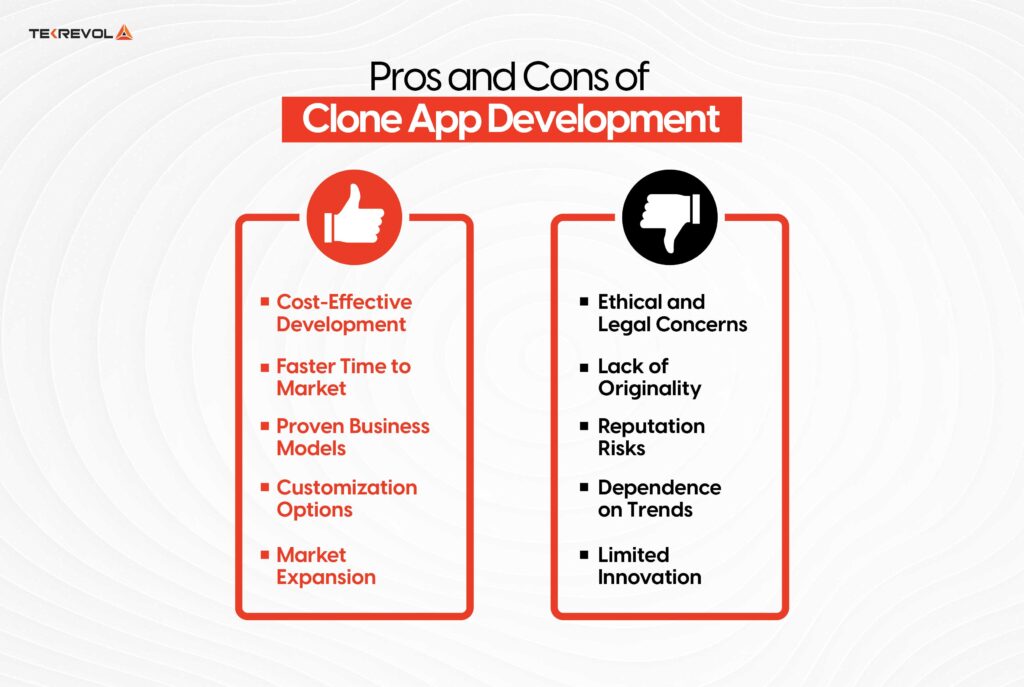
Despite the negative views surrounding app cloning, particularly regarding intellectual property concerns, it serves a legitimate function. That is why below, we shed more light on both sides of the argument which should assist you in making an informed decision.
Pros
Cost-Effective Development
Clone app development can help businesses proceed faster and at a lower cost because it has a tested structure. There is no need to start building from the ground, which is a very expensive method.
Faster Time to Market
Once the solutions are built, your app takes much less time to enter the market than a custom-developed solution. This is particularly useful in the sectors where competition is stiff.
Proven Business Models
As you closely follow a successful app, you understand the idea has merit and has been tested before. It is easier for a company to embark on since it eliminates the risks that come with introducing a new concept in the market.
Customization Options
You are not simply cloning – you can incorporate additional functions, recolor the layout, and even modify the application for certain segments or territories.
Market Expansion
Clone applications are perfect for penetrating new or less-developed markets if the initial application is not accessible in some areas.
Cons
Ethical and Legal Concerns
Clone apps always operate close to the legal restrictions on intellectual property. But do remember that without permission or where there are distinct differences in the API, you may encounter legal problems.
Lack of Originality
It becomes quite difficult for a clone app to succeed if it doesn’t introduce at least an additional functionality that wasn’t presented in the original app. Which is seemingly detrimental in fully saturated markets.
Reputation Risks
While some other users and businesses might find clone apps as fakes or unfair in some manner, this could affect your brand reputation.
Dependence on Trends
Depending on how much the original app has been popular, your clone app too may become unpopular and this puts you in a weak position in the market.
Limited Innovation
Paying more attention to cloning rather than innovating may actually limit creativity and potentially even block your business from emerging as a leader in the market.
Why Clone App Development is Gaining Popularity
The use of mobile apps has dramatically increased and the figures show this. As of 2022, it was worth $206.85 billion and is projected to grow at a 13.8% CAGR between 2023 and 2030, as reviewed by GrandViewResearch. Here are some key statistics that showcase this dynamic growth:
- Clone app development saves developers significant time and money, reducing development time by up to 40% compared to building apps from scratch.
- With mobile app downloads reaching over 258 billion globally in 2022, users are increasingly drawn to apps that combine familiar features with innovative twists.
- Building clone apps involves using tried-and-tested concepts, which greatly decrease the likelihood of failure. Considering the 80-90% failure rate for new apps, cloning a proven idea provides a more secure approach.
Clone App Creation: The Ethical Dilemmas You Can’t Ignore
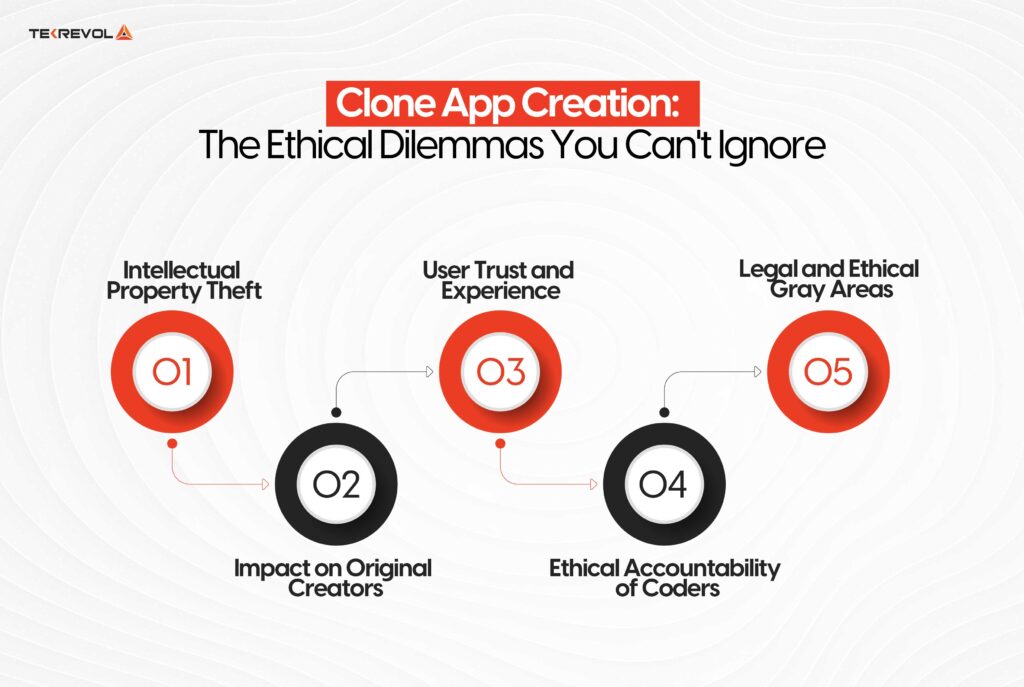
Try to envision this. You spent countless hours of time, your passion, and your money to develop an app that is fresh and useful. Then another person comes along, creates what you developed with a few modifications and gets rich from it. This is the shady ground of clone app development. Even though it may appear easy to achieve the practice has some of the following major ethical issues.
1. Intellectual Property Theft
Clone apps replicate the looks, performance, or concept, making it enter the realm of piracy. People who create the first application spend much money and time on development. Research has revealed that piracy, particularly the cloning of software, is said to harm the world economy with losses estimated to be about $46 billion.
Example: Using identical UI/UX designs, logos, or even the name of an existing app.
2. Impact on Original Creators
Clone apps can create a market that competes with the original app, thus causing problems for the original creators of apps. Another report released in 2023 estimates that as much as 30% of app revenues are lost due to market overcrowding by clones or fake apps.
3. User Trust and Experience
Replicated apps generally fail in terms of delivering the quality and support that came with the original application. A news source reported that 43% of mobile users who installed cloned or fake apps by mistake had malware problems or data loss.
4. Ethical Accountability of Coders
Developers who create clones face a moral question: Is it right to benefit from an idea that was generated by another person? Where some claim they are ‘improving’ or ‘making it more available. In the survey on ethical practices carried out among developers, 67 % considered cloning of an application without the owner’s permission as unethical, though not unlawful.
5. Legal and Ethical Gray Areas
While some clones may not copy the work directly and may make small changes, they, in fact, fall more in a ‘grey area’. Research shows that one in four application-related legal cases in 2022 involved the cloning or infringement of intellectual property rights. This does not make the practice ethical; it merely takes advantage of legalities and technicalities to explain the actions.
Navigating the Clone App Landscape: What You Need to Know
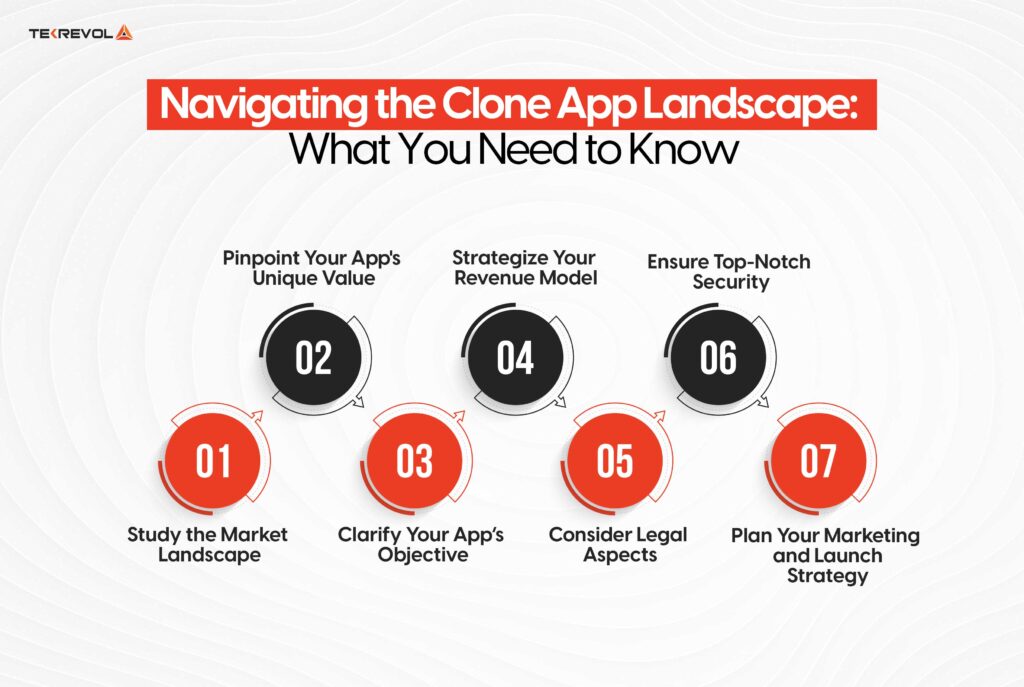
Instead of emphasizing imitation, clone app development is more about how to make a rational and effective approach. Below are some top issues that would need to consider before you start developing your clone app to help make it a success:
Study the Market Landscape
Users need to carry out a market analysis to determine their competitors and what users want. Spend time with existing apps in your chosen area to review their success, failure, and user evaluations. This will enable you to identify areas of strength in your app as well as areas of weakness to fill in the market.
Pinpoint Your App’s Unique Value
The best clone app is not just an imitation of the original application, but it must offer the user something more. Look for ways on how one could add value to the features or functionality of the existing application concerning the clones that are already standing out in the market.
Clarify Your App’s Objective
What’s the main reason your app exists? Whether it’s to solve a pain point or enhance user convenience, knowing this upfront is a game-changer. Make sure the design and functionality mirror that purpose—it’s how you turn a concept into something users will love.
Strategize Your Revenue Model
Consider how are you able to profit from your clone app. Pick an ideal monetization method for your application based on the app’s description, advertising, paid subscription, or a combination of both. When adjusting for prices, remember to benchmark your competitors and adapt where necessary.
Consider Legal Aspects
A legal issue that may arise when cloning an app is ownership rights especially as they relate to intellectual property. Make sure that you are aware of the copyright laws, licenses, and any legal implications as well. Seeking legal personnel advice means your application will be safe and free from legal issues.
Ensure Top-Notch Security
The security of data and the confidentiality of users should always be considered. Use controls like confidentiality and integrity when addressing security issues affecting the availability, confidentiality, and integrity of data.
Plan Your Marketing and Launch Strategy
An effective marketing strategy is of great importance when it comes to any application. Concentrate on the identification of an appropriate target market and proper choice of promotional media. To deal with this challenge, you can use social networks, invite influencers, and other techniques to stir up interest around the launch.
Roadmap to Creating a Successful Clone App

Developing the clone app is quite effective for those who are trying to invest in an already successful and effective idea but with their own idea input. But again, as with any app development process, it is a strategic and careful process. Here’s how you can approach building a clone app:
1. Dive Into the Market Research
The first thing you should do before jumping into creation is acquaint yourself with what is out there. Take the time to study the applications of your targeted category and find out what is effective. Know what the users among the populace prefer as well as the areas that are not filled.
2. Set Your Intentions Early
What are you expecting to achieve out of your app? This is a point where you define which aspects of the site you would like to mirror or modify to suit your needs. Do you want to optimize particular features of an original application? These objectives are best set at the beginning of the process so that the entire team stays motivated and on track.
3. Craft the User Experience (UX)
Design isn’t about what the app looks like, it’s about how it feels when you’re using it on your mobile. Sketch the first rough drafts on paper, prior to developing the final layout of the website. When using navigation, make sure it is as fluent as possible.
4. Develop the App
Finally comes the real action – the implementation of the app. Check out the best technology for your app and code. This is where all of the features come to life and you ensure that your software will work across several platforms.
5. Test Like It’s Your First Launch
Testing is your opportunity to ensure that all components of the software run smoothly. Test your app on almost any device and operating system you want to stress it on.
If you can take your app to beta testers, they can give you a real-world picture of how users might behave with your app and the necessary adjustments may be made.
6. Get Ready for Launch and Beyond
When your app is built and tuned to suit your needs, it is now time to launch your app into the app stores. Come up with an interesting description, select some appealing screenshots, and develop a marketing strategy to share it.
But the job does not end there because post-launch involves other activities. Monitor user reviews, assess the level of interaction, and strive to make further enhancements to the application to meet the market’s demands.
Popular and Profitable Clone App Ideas in 2025
Clone apps are becoming a more and more popular option for business owners wishing to venture into different sectors. Some of the best clone app ideas that might help you reach established marketplaces and draw consumers fast are listed below.
| Clone App Idea | Overview | Opportunity |
| Uber Clone | A ride-hailing app for booking rides and making payments. | Ideal for entering the on-demand transportation market. |
| Spotify Clone | A music streaming app with personalized playlists and offline listening. | Great for tapping into the growing music streaming demand. |
| Etsy Clone | A marketplace for handmade, vintage, and unique goods. | Perfect for empowering small businesses and artisans. |
| Netflix Clone | A video streaming platform with movies, TV shows, and original content. | Enter the booming on-demand entertainment market. |
| Instagram Clone | A photo and video-sharing app with filters, stories, and reels. | Ideal for leveraging the popularity of visual social media content. |
| TikTok Clone | A short-form video platform for creating and sharing creative content. | Capitalize on the viral growth of short-form video content. |
| Zomato Clone | A food discovery and delivery app with real-time tracking. | Enter the growing food delivery market. |
| Fiverr Clone | A freelance marketplace for digital services. | Perfect for tapping into the gig economy. |
| TaskRabbit Clone | An app for outsourcing tasks like cleaning, assembly, and errands. | Serve the demand for on-demand personal services. |
Understanding the Risks and Realities of Clone Apps
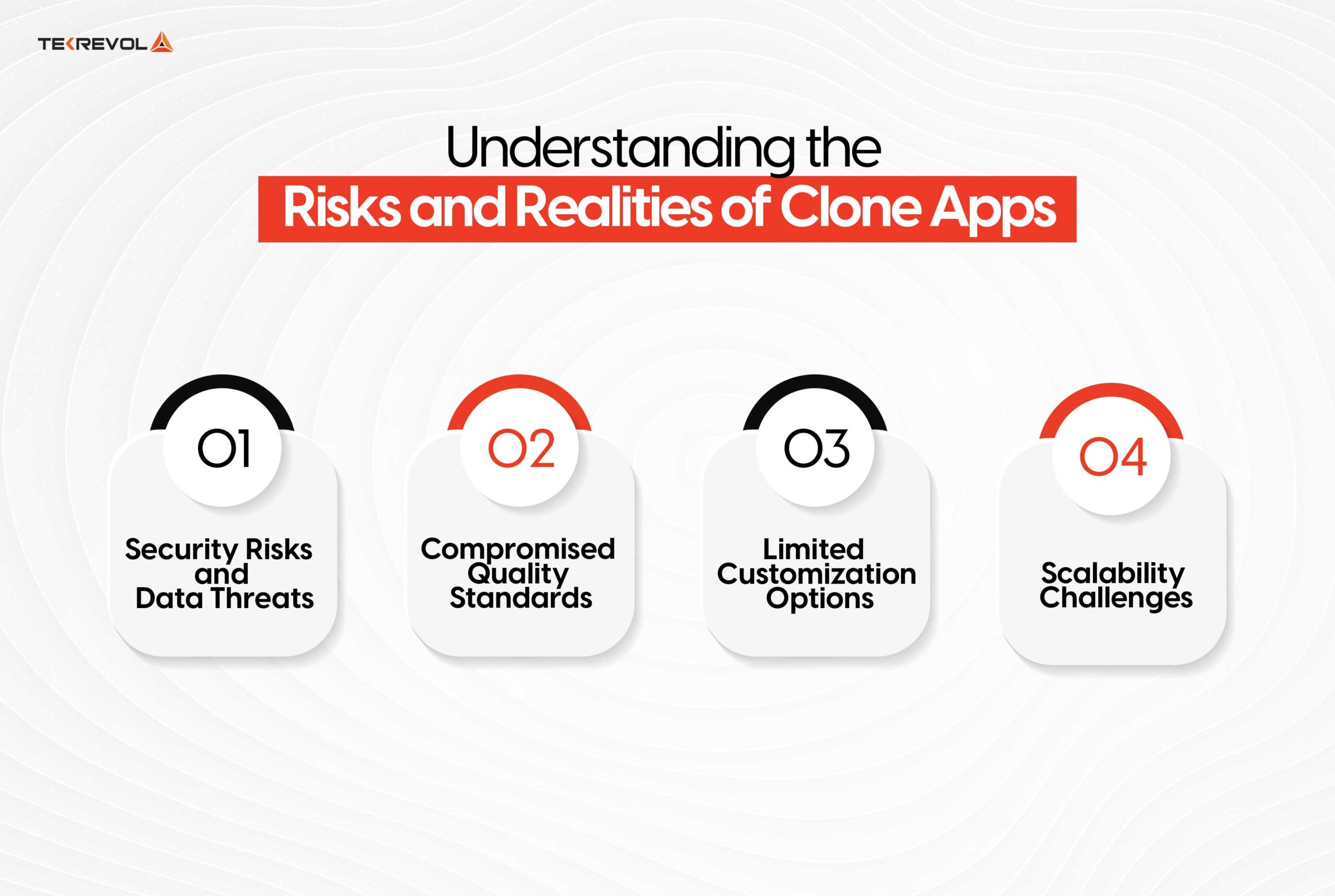
Although app cloning may appear as one of the best practices to start shifting market shares, there are many risks associated with it notably for the Android operating system. From security threats to scalability issues, here are the major challenges:
1. Security Risks and Data Threats
It is important to realize that not all cloned apps are nice. Some alter their functionality, insert malware, or conceal them to steal user information. Therefore, it is easy to generate clones that mimic download managers but can lead to the installation of further harmful software. This poses a security and privacy risk for both users and app developers.
2. Compromised Quality Standards
Clone apps tend to have generic scripts, they may have coding blunders and poor usage by customers. The fake and substandard versions can easily be pulled from the app stores resulting in losses and a blow to your credibility as a developer.
3. Limited Customization Options
Almost all clone scripts have standard features that do not allow users the freedom to tweak their site. However, if your app needs complex features, such as payments or location tracking, these clones can be disappointing for developers and their clients.
4. Scalability Challenges
cloned apps lack a robust architecture capable of supporting rapid growth. These apps may be unable to adapt or expand in tandem with their user base, resulting in frequent crashes and lost economic opportunities.
Best Practices for Identifying Cloned Software
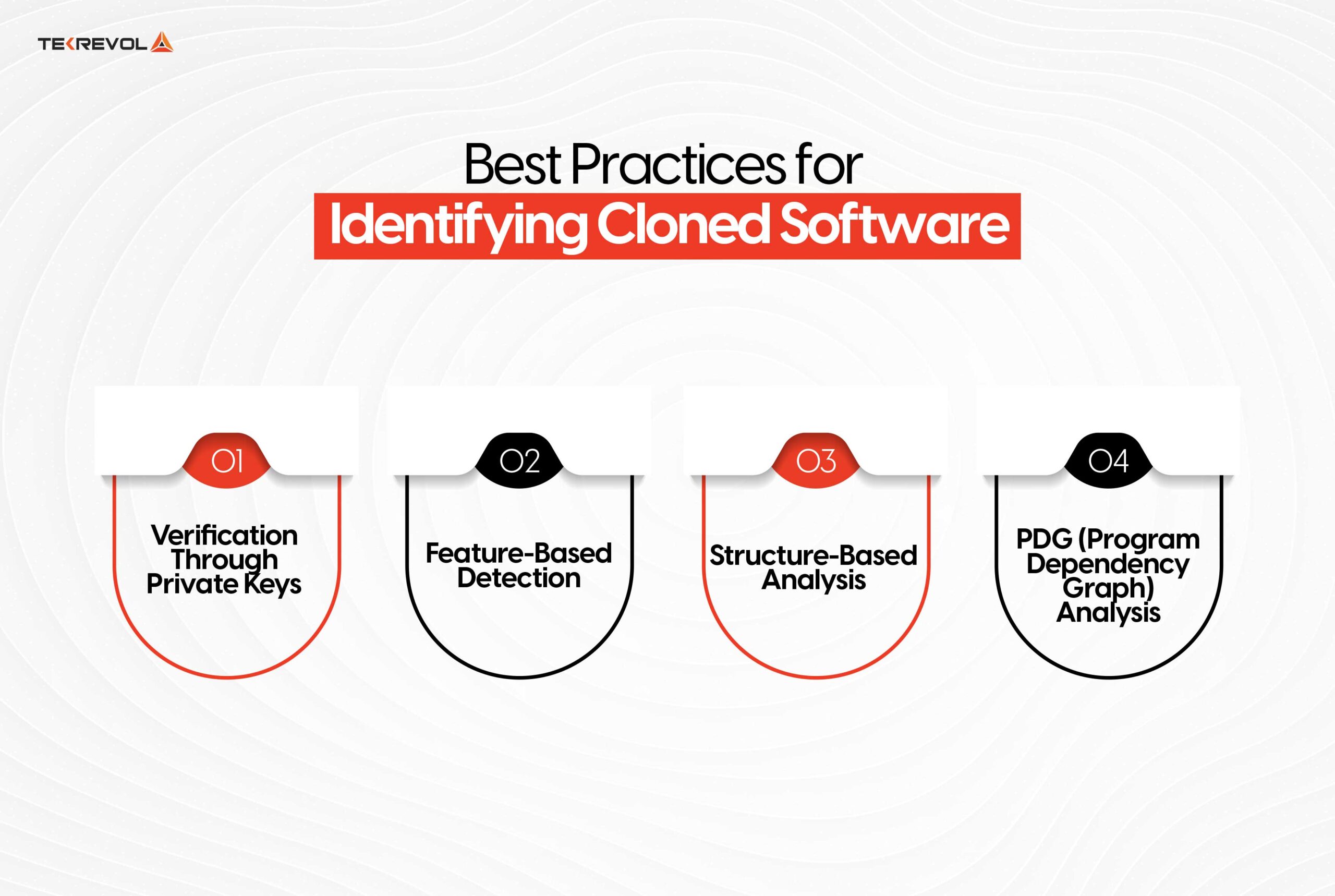
App cloning is a big problem today and is most likely to grow where there is intense competition. Here are some reliable methods to detect cloned apps and ensure authenticity:
1. Verification Through Private Keys
Every application on the Google Play Store has its unique private key used for signing the application. It is also possible to find cloners by comparing the keys of similar applications. If there is any mismatch of keys, then this is a clear sign that there is duplication hence needs to be investigated.
2. Feature-Based Detection
Clones can be distinguished by looking into such factors that an app may contain, for instance, names of classes, loops, or libraries. However, this approach tends to highlight the complex elements and can fail to consider structural resemblance which leads to low accuracy.
3. Structure-Based Analysis
This approach examines the program and separates it into tokens to detect patterns in the code structure. This makes it more reliable because it hides common comments and variable names, which can easily lead to false detection. However, it is important to note that sophisticated code changes may go unreported.
4. PDG (Program Dependency Graph) Analysis
This method is much more refined compared to the previous ones as it utilizes data and control dependencies within app code to locate clones. Because it looks into the program structure, it is the only way that can identify cloning even when modifications have been made to cloned items.
Technical and Business Challenges in Clone App Creation
Despite, clone app development being an effective way to enter the market as soon as possible, there are some issues that the developers and the businesses have to face seriously. Let’s take a closer look at some of the key obstacles:
1. Legal and Ethical Complications
When creating a copy of an app, the result may be the violation of intellectual rights, which in turn leads to the initiation of legal proceedings. Failure to acquire necessary licenses or permits exposes developers to violation of the copyright act.
That is where adding features and providing value can be particularly useful to stand out from the competition without going over what is legal or ethical.
2. Lack of Innovation
Clone apps mimic other apps and therefore it is more challenging to develop a unique selling proposition. Despite the time- and cost-saving, it may lead to the impression that they are rip-offs. For developers to achieve success in a competitive market, they had to give their clone applications something new and unique.
3. Limited Customization and Scalability
There is a limitation in flexibility when pre-built scripts are used. Using advanced features in the application may make it difficult for developers to add the application or make changes to meet new users’ demands. On the flip side, a rigid app architecture can stifle growth resulting in limited scalability making it a con.
4. Brand Reputation Risks
Imitating an existing app can only have a negative outcome because it will be compared to the popular one. The audience will consider it as an imitation product that is substandard, thus harming the brand image. To avoid this, find how to address other problems or how to add value to the application interface where others do not.
5. Dependence on the Original App’s Trajectory
Clone apps depend on the original and are affected by it in various ways. If the source app is out of fashion or has problems or becomes outdated then its clone may also be out of fashion or have the same problems. Cloning is necessary if a developer concludes that the model used has long-term stability and is prepared for a change if necessary.
How to Budget for Your Clone App Development Project
The cost of developing a clone app can also differ depending on the complexity and features you’d like to see in the clone app and development strategy. Whether you are to develop a basic or feature-rich application, learning the costs is vital for project management. Here is a breakdown of costs and development time for different types of clone apps:
| Type of Clone App | Estimated Cost | Development Timeline | Key Features |
| Simple Clone App | $10,000 – $25,000 | 1 – 3 months | Basic design, essential features, and single-platform compatibility. |
| Moderate Complexity App | $25,000 – $55,000 | 3 – 6 months | Enhanced features, better UI/UX, and support for multiple platforms. |
| Complex Clone App | $55,000 – $200,000+ | 6 months – 1 year or more | Advanced functionality, custom integrations, scalable architecture, and more. |
Factors Influencing Clone App Costs
The total cost of your clone app is influenced by more than just its complexity. Here’s what else matters:
- Development Approach: Choosing between native, hybrid, or web-based development.
- Platform: The cost can vary depending on whether you’re building for iOS, Android, or both.
- Feature Set: Adding advanced features like AI, payment gateways, or third-party integrations can raise costs.
- Design Complexity: Customizing your UI/UX design can contribute to the overall price.
- Development Location: Costs differ depending on the region, such as the USA, Europe, or Asia.
- Maintenance & Marketing: Ongoing updates and post-launch marketing will add to the cost as well.
- Curious about the cost of your clone app?
- Use our cost calculator to get a precise estimate tailored to your project.
Need Assistance For Your Clone App Development?
We all know that clone apps come with their own set of challenges and ethical concerns, but they can also offer a huge advantage for businesses looking to enter the market quickly.
Thus, clone apps save time on application development, cost less, and guarantee that the business model will be effective for many companies. But one must not neglect the potential negative impacts such as legal issues, unoriginality, and oversaturation. The biggest issue is knowing how to mimic those strategies in your restaurant but at the same time bring something new to the table.
At TekRevol, we are ready to offer you comprehensive assistance in creating a clone app from scratch. As a leading mobile app development company in Austin, we offer comprehensive support to ensure your project’s success. Whether you need assistance in protecting the rights of an intellectual property or need legal advice or someone to guide you in the adoption of additional features, we have everything that can make your project a success.

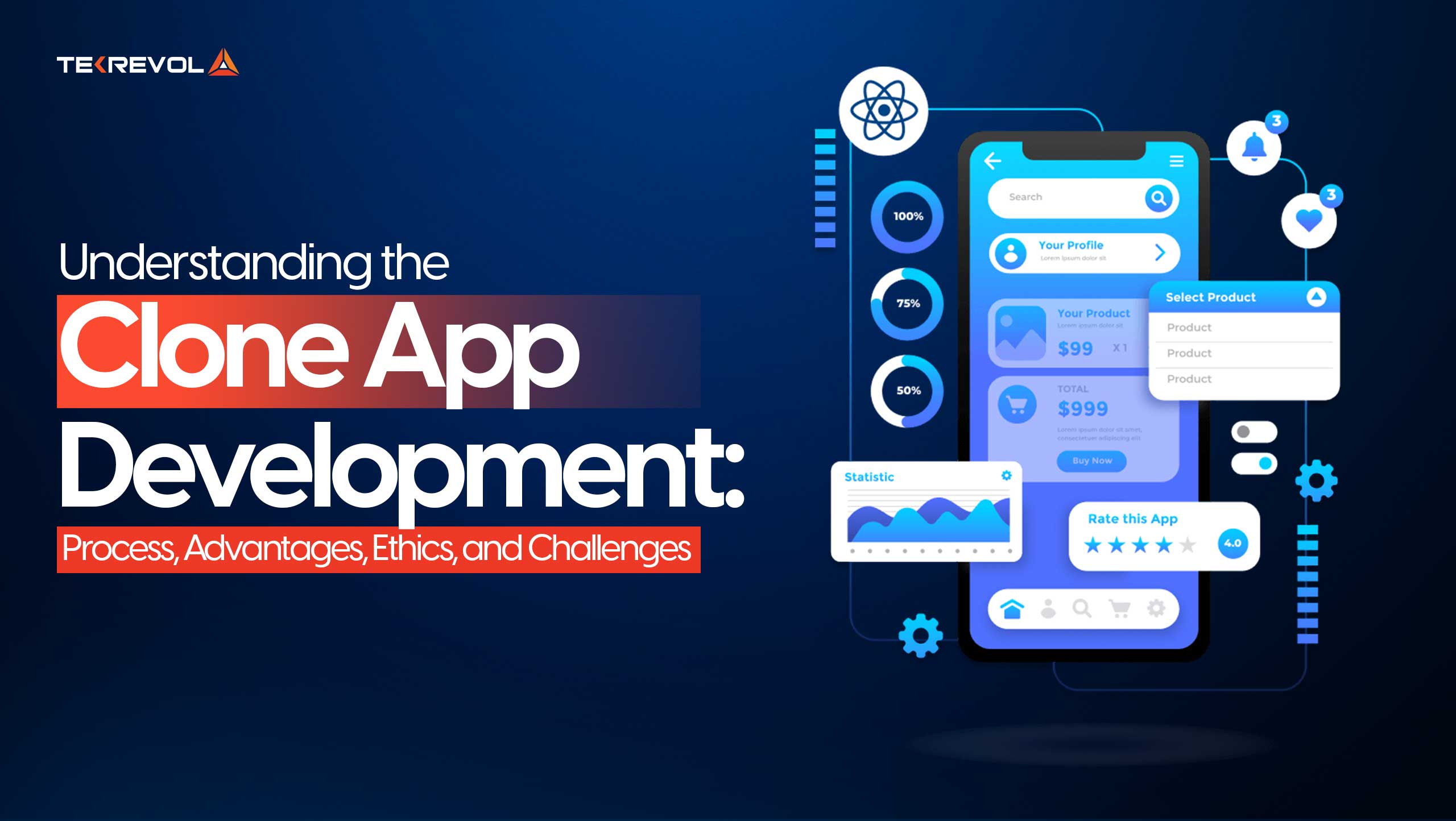



![Top 10 Mobile App Development Companies in San Diego [2025 Guide]](https://d3r5yd0374231.cloudfront.net/images-tek/uploads/2025/09/Featured-ImageTop-10-Mobile-App-Development-Companies-in-San-Diego.jpg)




